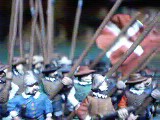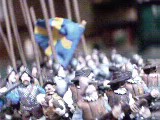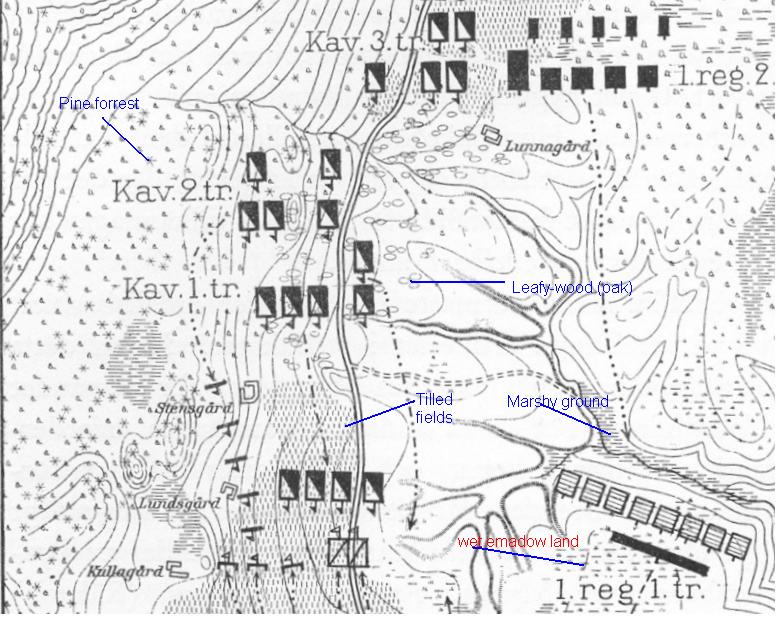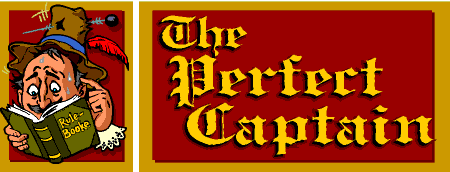The
Battle of Axtorna, 1565
a
scenario for Spanish Fury, Battle!



Introduction
On the 16
of october 1565 the Danish commander Daniel Rantzau raised his
siege of Varberg and gave up his attempt to
recapture the strategic fortress. Moving south towards
his winter quarters in the Danish province of Scania he found
his way
barred by the river Ätran. A fast moving Swedish
detachment commanded by Knut Hakansson Hand had destroyed the only
bridge across the river. Rantzau march north along the river
in order to use the fords located upstream. However this
move took
in towards the approaching Swedish army rather than away from it.
Reconaissance showed that only the fords at Axtorna
were usable due to the time of year and Rantzau moved towards
small village.
On the
other side of the hill King Erik of Sweden had rejoined his army a
few days march north of Axtorna and order
the newly apointed commander Joacob Henriksson Hestesko to
concentrate the army and seek out Rantzau and force him
give battle "whenever and whereever" possible. Hestesko swiftly
concentrated his army and began to move south
towards Rantzau.
On the
20th of october the two armies met at Axtorna, Rantzau had arrived
first and had take up a strong defensive postion
with his smaller army,a postion which secured his line of retreat
across the fords. Rantzaus army was the entire army available
to the Danes in 1565 except for the garrisons of the Danish
fortresses and the detachements aboard the fleet. If Rantzaus army
was lost the eastern Danish provices would be defenceless. This
meant that he had little incentive to fight a risky battle
with a larger enemy force. However Hestesko was determiend to
follow the Royal command he had been given and
he decided to commited his larger army to battle despite the
strenght of the Danish position, much to Rantzau's
surprise.
The
set the stage for the largest battle of the Nordic Seven Years War as
Jacob Hestesko advance his army of 3000 horse
and 8000 foot supported by 42 guns against Daniel Rantzau's 1600 Horse
and 6000 foot supported by 21 guns.

The Board
6 by 4 foot wargames
table will cover at 1 inch= 27.5 meters or 30 yards which is the scale
I use for my games.
The
Terrain:

All hills
are considered "Low Hills".
The leafy
woods are considered a minor obstacle
to Foot regiments and a Major obstacle to Horse regiments,
this also applies to the patch of Pine forrest which the Swedish
cavalry passed through. All other forrests are
impassable to formed troops but routers will seek shelter in them. The
Högvadså is impassable to all
except at the fords. The
Myrån stream can be forded by foot regiments along it's entire
lenght but horse
regiments can only cross it at the bridge.
The other streams are treated as minor obstacles
for both Horse and Foot regiments.
The fields have been harvested and are
treated as clear terrain. The wet meadow land over which the "1 reg.
1tr."
is shown moving is treated is no problem for troops moving at marching
speed, if troops move faster they must take a
marshalling test as when moving across a minor obstacle. (Ie it
is possible to move through the meadows at the
double or charge rates but you risk disorder)
As can be
seen on the map the village of Axtorna consisted of 7 farms with a lot
of distance between each,
the village proper is formed by Eskilsgard, Kullagard, Lundgard and
Stensgard. Due to the way in which these
basicly medieval farms are built they are unsuable as defended
postitions (no windows or openings on the outside walls)
except for the larger Eskilsgard whose outbuildings and fences
will provide coverand a defensible position for up
to 8 figures of Enfants perdue.
I've not includede any rules
for the Danish baggage train and it's supposed wagon fort, partly
because I'm not
convinced it played any part in the fighting, partly beacuse I've
not come up with any easy rules for it.


The Swedish army
If playing the historical
scenario without the optional "Erik XIV at Axtorna" rule the army
starts with a
confidence of "Resolute"
Generalissimo (Jacob Henriksson
Hestesko)
1st brigade: Lindorm
Persson
2
"Landsryttare" regiments (8 fig each)
1 Reiter
regiment (8 fig)
2nd
brigade: Erik Gustafsson Stenbock
2 "Landsryttare" regiments
One of these is the combined
"Adelsfana" (8 fig)made up of nobles and carries the "Hufvudbaner" flag.
The other is Jakob Perssons Ostgota regiment (6 fig)
1 Reiter regiment (8 fig)
3rd brigade
(In reserve): Harald Törilsson
2
Landsryttare regiments (8+6 fig)
1 Svarta
Ryttarna regiment (12 fig)
4th brigade:
Hogenskild Bielke
1
"Konungens eget" regiment (63 fig)
2
"Förlorade hopar" regiments (12 fig each)
5th
brigade: Åke Bengtsson Färla
2 Veteran
Enfants Perdue detachment (16 fig each)
6th brigade (In
reserve):Tönne
Olsson
1 "Konungens
eget" regiment (50 fig)
1 "Förlorade hopar" regiment
(12 fig)
(In
reserve)
The
artillery:
1
Artillery battery (Demi-Culverns/Average Gunners)
1
Artillery battery (Sakers/Average Gunners)
4 Artillery batteries (Falcons
and Falconets/Average Gunners)
Deploy
all 6 batteries together supported by 2 Enfants Perdue
detachments (8 fig each) which are attached to the
ridge on which the artilery is deployed including the Eskilsgård
farm.
The Byaberg:
1 Enfants
Perdue detachment (8 fig)attached to the Byaberg hill.
* * *

The Danish armyAlways starts with a
confidence of "Equapoised"
In this battle the Danish army
has a 9/7 Fortuna number when "Desperate"
Generalissimo: Daniel Rantzau
1st brigade: Peder Gyllenstierne
1 "Rostjenste"
regiment (8 fig)
2nd brigade: Josua
von Qualen
1 Reiter
Regiment (8 fig)
1 "Rostjenste" regiment (8 fig)
3rd brigade: Henrik Tornow
1 "Hoffanen" regiment (8 or 10 fig)
1
"Musefanen" regiment (6 fig)
4th brigade:
Frands Brockenhuus
2(1)
Landsknecht Regiments (Rantzau's regiment 72 fig, von Holle's
regiment 54 fig)
3 (2) Enfants Perdue detachments (8 fig)
(As an optiona rule deploy a 5th
brigade with the following units drawn from the above)
Optional 5th Brigade: Streckfuss
1 Landsknecht
Regiment (von Holle's, 54 fig)
1 Enfants Perdue detachment (8 fig)
The artillery:
Western
battery
1
Artillery battery (Demi-Culverine/Average Gunners)
1 Artillery batteries (Sakers/Average Gunners)
Eastern
battery
1 Artillery battery (Sakers/Average Gunners)

Scenario Rules
Length of the Game
The battle started at 12 AM and contiuned
until dusk, this is about 24-28 turns in Battle!
Deployment
The Danish infantry brigade(s)
starts in the area shown on the map (the postions of the two red
"squares which I had drawn
on the map rather than the position shown on the map in
black) one regiment (or brigade) behind the other. The area
is roughly
12 by 8 inches. The enfants perudue of the brigade(s) may deploy
up to a charge move away form the landsknecht regiments.
The Danish cavalry brigades
should deploy in 3 lines in the order of 1st, 2nd and 3rd brigades in
the area shown on
the map, this area is 7 by 10 inches on the table. The brigades have their regiments in line with each
other.
The Danish artillery batteries
deploy in the positions shown on the map.

The Swedish cavalry brigades should
deploy in the areas shown for each brigade, each area is roughly 8 by 6
inches
on the tables. The regiments of each brigade may sent up in any
way the want inside that area.
The Swedish infantry brigades
deploy as follows:
The two brigades made up of the
Kings own regiment (Bielke and Olsson)
set up in the areas shown, each area is
12 by 6 inches on the table. Färlas
brigade of infantry set up in the areas shown, the area is 8
by 4 inches. The regiments
of each brigade may sent up in any way the want inside that area.
Victory conditions
The Swedes win if they
reduce the Danish confidence below "Hopeless". If they do so while in
controll of or blocking the
ford across the Högvadså the Swedes win a decisive victory
which might very well decide the war. The Danish army present
at Axtorna is the entire Danish field army
in existence in 1565 and the ford is it's only way of reaching the
safety inside
Danish territory. Controll of the ford alone does not allow the Swedes
to claim victory.
The Danes win if their
confidence level has not been reduced below "Hopeless" by
nightfall and they are in controll of the
ford across the Högvadså.

Optional rules
1:
Streckfuss takes command!
Frands
Brockenhuss was in command fo the Danish infantry made up of Rantzau's
combined regiment of
Landsknechts and native Danes aswell as Von Holle's regiment of
Landskenchts. There is some evidence that
Holle's regiment commanded by it Locotenent
(lieutenant-colonel) Lazarus Streckfuss acted in a way that
justifies
it's deployment as a separate 5th Danish brigade commanded by
Streckfuss.
2:
The Guns of the Byaberg
The
Swedish skirmishers which held the Byaberg had with them a small
battery of small calibre swivel guns with
which they were happily taking pot shots at the Danes. In order to
simulate these guns use these rules:
Range: 9
inches
Roll 1 D6,
on 6 the target suffers 1D, if the targe tis with in the Enfants
perdue's close range a hit is scored on a 5-6.
These guns
are light enough to be dragged forward by hand but cumbersom enough to
reduce the Enfants perdue to
max movement of 1/2 march move. The swvel guns and their crews
are considered a part of the Enfants perdue
detachment for all purposes and are permanently lost if the
detachment suffers a Retire, Rout, Give Ground
or Breal&Rout result on a waver test or in combat. If lost
the Swedish army suffers a Cause for Alarm with a
+1modifier on the die roll, if the Swedes suffer more than
one CfA that turn the loss of the swivel guns only
modify the Swedish die roll by a -1not the -2 a previous CfA
would add to the die roll.
3:
It can't rain all the time, can it?
Accordign
to some but not all accounts of the battle of Axtorna several rain
showers happend during the battle.
Roll a D6 at the start of each turn, on a 6 it rains
enough to impact the use of firearms. All shooting, both
artillery and small arms suffer a -1 modifier for that
turn.
4:
Erik XIV at Axtorna! (Recomended)
King Erik
XIV had yet to suffer his first large mental breakdown, use the
following table instead of the one provided
in the army briefing if using the Erik XIV table rule:
1-2
Fearfull of both the uppcoming battle and a rumored conspiracy in
Stockholm King Erik withdraws from
the army. He takes the pay chest with him and reinforces his Royal
Guard escort with an additional 12-16 figures
(roll a D6 1-3 12 figures, 4-6 16 figures) from the King's Own
regiment and replace the Svarta Ryttarna regiment with a
6 figure Landsryttare regiment The army is not paid and starts the
battle with a confidence of "Equipoised
3-5
King Erik reviews the army, makes an inspiring speach and pays the
soldiers who swear to do their utmost. After this
he withdraws with parts of Royal Guard to his headquarter which
is located in a safe place some distance from the battle
to await the messeanger bringing him word of the armys glorious
victory. The army is paid and content and the
commanders confident as they deploy for battle. No changes to the
Swedish order of battle and the Army's confidence
is "Resolute"(Historical result)
6
King Erik decides to lead the army in person. Replace Hestesko with
Erik XIV as Genralissimo of the Swedish army,
Replace one random Swedish leader with Hestesko. The army is paid in
full and swears an oath to do its utmost
and it's inital confidence is "Resolute" The Royal Guards prepare to do
battle alongside their King, add
12-16 figures (roll a D6, 1-3: 12 figures, 4-6: 16 figures) to one
"Kings Own Regiment" unit and
one 16 figure "Blanka ryttarna" regiment to the Swedish order of battle.
5: Treacherous Reiters! (Recommended)
Several of the Reiter units in
Swedish service proved higly unreliable in 1565, Drachstedts cornet
actualy left the battlefield at
Axtorna without firigna shot or striking a blow and several cornets
deserted to the Danes during the winter. The first time
a Swedish Reiter regiment rolls a -1 or H
result on a To Charge or Charged by Cavalry waver test the reult is
instead a TR "Treacherous Reiters"
response which is identical to a Ln result in the ordianry rules.
Once one Swedish Reiter unit has suffred a TR result
the other will prove to be
loyal and will treat it's waver test reuslts as in the ordinary
rules.
Questions? Send us a
message at-
The
Perfect Captain
Home
to

Nordic
Fury Mainpage
- Or -
The
Captain's Homepage

![]()
![]()

![]()


![]()

![]()